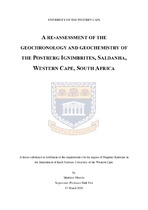| dc.description.abstract | The Saldania Belt in southern Africa, a product of the Pan-African Saldanian Orogeny, forms part of a system of Neoproterozoic mobile belts that border and weld older cratons on the African continent. It is a low-grade orogenic belt situated along the southwestern margin of the Kalahari Craton and is composed of several inliers of greenschist facies metasedimentary and metavolcanic rocks (Malmesbury Group), unroofed in megaanticlinal hinges of the Permo-Triassic Cape Fold Belt. The Malmesbury Group rocks were syn- and post-tectonically intruded in a pervasive transpressive regime between 555 Ma and 515 Ma by Neoproterozoic to early Cambrian S-, I- and A-type granites, monzodiorites, gabbros and quartz syenites, which collectively constitute the rocks of the Cape Granite Suite (CGS). Along the south-western coastline of South Africa, the Saldanha Bay Volcanic Complex (which forms part of the CGS) is divided into two eruption centres both of which have been identified as “intra-caldera pyroclastic ignimbrites”. The Postberg eruption centre is situated to the south of the Saldanha Bay entrance and the Saldanha eruption centre is situated to the north of the entrance. Both eruption centres display distinct geochemical signatures, the most apparent being the greater TiO2 concentrations (> 0.25 wt. %) of the Saldanha centre ignimbrites when compared to its Postberg centre counterparts.
The Postberg eruption centre consists of S-type rhyolitic ignimbrites which are subdivided into the two geochemically distinct Plankiesbaai and Tsaarsbank Ignimbrites. Small amounts of the Jacobs Bay and Saldanha Ignimbrites (less felsic tephra from the Saldanha eruption centre) are also present in the Postberg eruption centre. A robust geochemical analysis of both the Plankiesbaai and Tsaarsbank magma groups display high SiO2 content (>76 wt. %), a lack of variation in TiO2 and Zr, high Al2O3 and ASI (aluminium saturation index) values (> 1.0 and generally >1.1 which, on average, is higher than the Saldanha eruption centre ignimbrites), low CaO and Na2O, and a highly ferroan character. The Plankiesbaai ignimbrite also display lower #Mg concentration compared to the Tsaarsbank ignimbrite. Typical geochemical trends in the Postberg eruption centre include the lack of variation in Zr content, higher Rb content and lower Sr, Ba, V and Zn concentrations when compared to the tephra of the Saldanha eruption centre found in the Postberg area.
The study’s main aim is not only to assess the geochemistry of the ignimbrites relative to the previous phases of magmatism originally proposed by Scheepers (1995) for the magmatism of the Cape Granite Suite, but also their age distribution. Previously defined phases of magmatism include Phase I (S-type granites subdivided into Sb, Sa1 and Sa2 all of which are dated to 555 - 540 Ma), Phase II (I-type granites subdivided into Ia and Ib both dated to 540 – 520 Ma), Phase III (A-type granites subdivided into Aa and Ab dated to ~ 520 Ma) and Phase IV (S-type volcanic and subvolcanic rocks dated to 515 Ma).
Re-examination of the geochronology displays a U-Pb age for Postberg Centre Jacobs Bay Ignimbrite (tephra from the Saldanha eruption centre) of 538 ± 2.2 Ma: and for the Postberg Centre Tsaarsbank Ignimbrite between 536 ± 2 Ma – 540 ± 3.4 Ma. These new dates, in combination with the geochronological work done in the Saldanha Centre (particularly in light of the Clemens and Stevens (2016) and Clemens et al. (2017) studies that reclassify these rocks differing from the original and previous studies), place all the ignimbrites of the Saldanha Bay Volcanic Complex securely within the age bracket for the initial S-type magmatism of the CGS.
This thesis presents a revised order for the phases of magmatism of the Saldania Belt, and by extension, of the Cape Granite Suite. All S-type magmatism, including that of the Saldanha Bay Volcanic Complex (Sv), forms part of the Phase I magmatism of the Saldania Belt (Sa1, Sa2, and Sb) emplaced between 555 – 540 Ma. | en_US |

